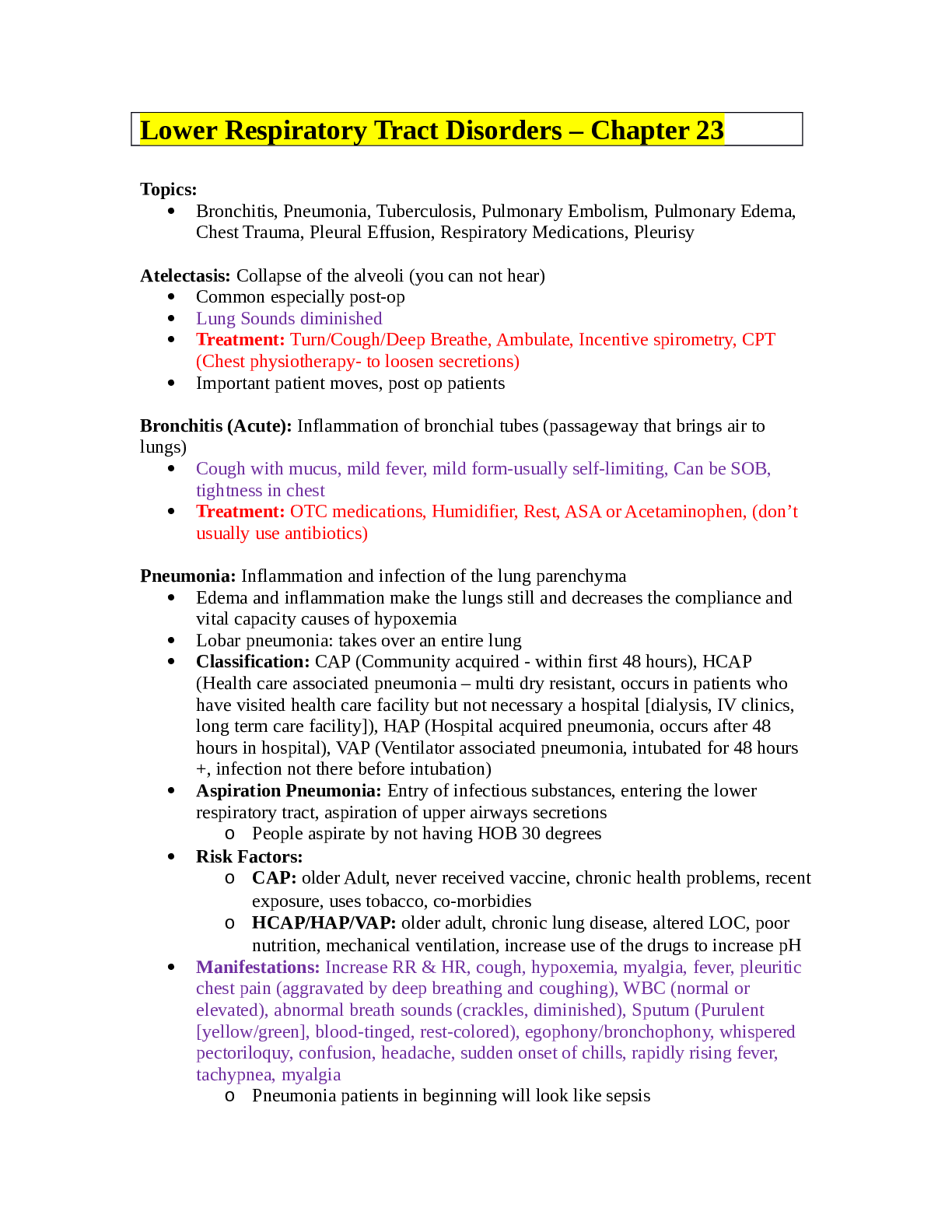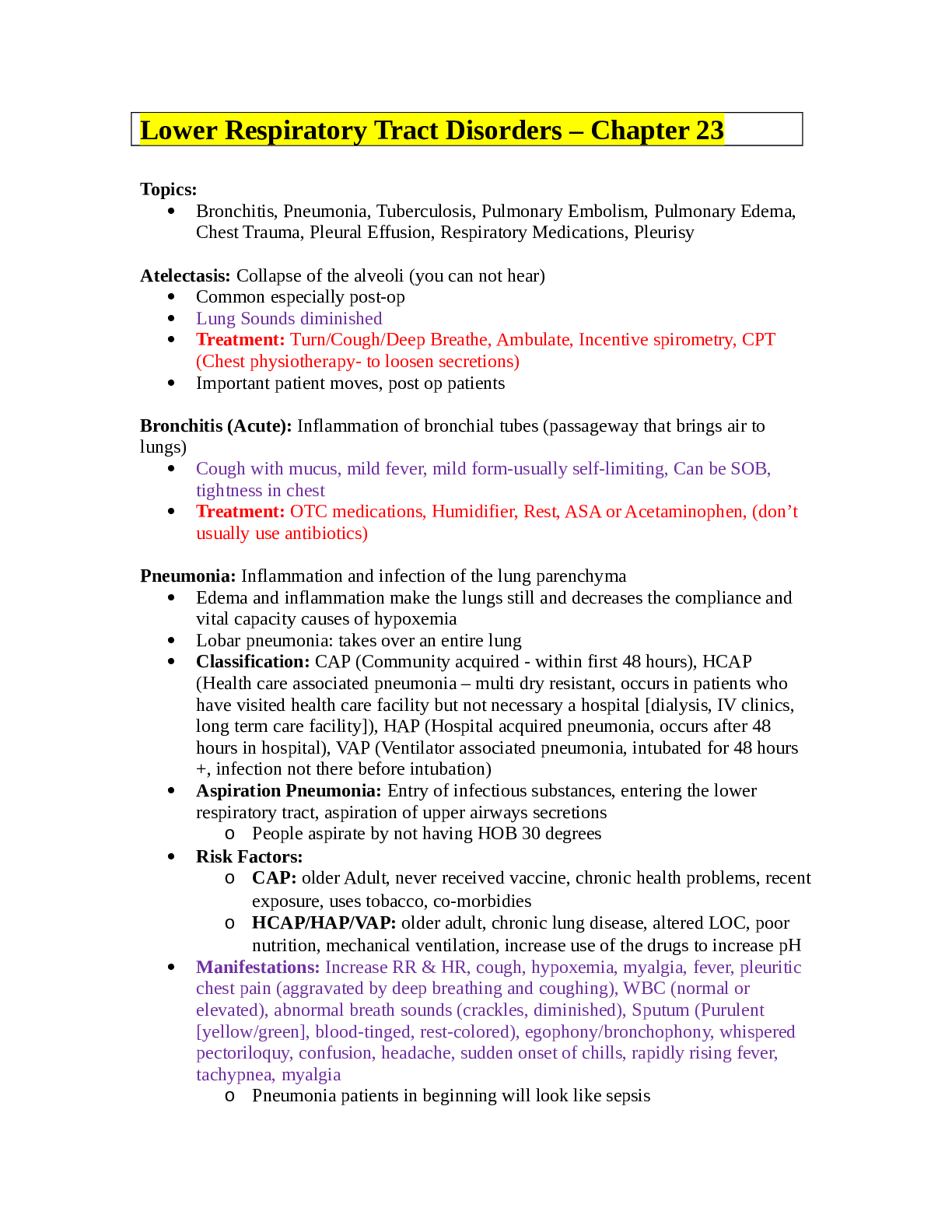Topics:
Bronchitis, Pneumonia, Tuberculosis, Pulmonary Embolism, Pulmonary Edema,
Chest Trauma, Pleural Effusion, Respiratory Medications, Pleurisy
Atelectasis: Collapse of the alveoli (you can not hear)
Common especially post-op
Lung Sounds diminished
Treatment: Turn/Cough/Deep Breathe, Ambulate, Incentive spirometry, CPT
(Chest physiotherapy- to loosen secretions)
Important patient moves, post op patients
Bronchitis (Acute): Inflammation of bronchial tubes (passageway that brings air to
lungs)
Cough with mucus, mild fever, mild form-usually self-limiting, Can be SOB,
tightness in chest
Treatment: OTC medications, Humidifier, Rest, ASA or Acetaminophen, (don’t
usually use antibiotics)
Pneumonia: Inflammation and infection of the lung parenchyma
Edema and inflammation make the lungs still and decreases the compliance and
vital capacity causes of hypoxemia
Lobar pneumonia: takes over an entire lung
Classification: CAP (Community acquired - within first 48 hours), HCAP
(Health care associated pneumonia – multi dry resistant, occurs in patients who
have visited health care facility but not necessary a hospital [dialysis, IV clinics,
long term care facility]), HAP (Hospital acquired pneumonia, occurs after 48
hours in hospital), VAP (Ventilator associated pneumonia, intubated for 48 hours
+, infection not there before intubation)
Aspiration Pneumonia: Entry of infectious substances, entering the lower
respiratory tract, aspiration of upper airways secretions
o People aspirate by not having HOB 30 degrees
Risk Factors:
o CAP: older Adult, never received vaccine, chronic health problems, recent
exposure, uses tobacco, co-morbidies
o HCAP/HAP/VAP: older adult, chronic lung disease, altered LOC, poor
nutrition, mechanical ventilation, increase use of the drugs to increase pH
Manifestations: Increase RR & HR, cough, hypoxemia, myalgia, fever, pleuritic
chest pain (aggravated by deep breathing and coughing), WBC (normal or
elevated), abnormal breath sounds (crackles, diminished), Sputum (Purulent
[yellow/green], blood-tinged, rest-colored), egophony/bronchophony, whispered
pectoriloquy, confusion, headache, sudden onset of chills, rapidly rising fever,
tachypnea, myalgia
o Pneumonia patients in beginning will look like sepsis
Assessment: Bronchial breath sounds (normal, but when you hear them in areas
of lungs where its not normal for them to be then it is abnormal.)
o Where do we normally hear bronchial breath sounds: over clavicles
o With Pneumonia you will hear bronchial sounds over any area of
consolidation
o Sputum sample off color, collect early in the morning
o Egophony- say E over and over, if it sounds like A something is wrong
o Bronchophony- When they say 99 it will sound clear, because air is better
transmitted in areas of consolidation, this is an abnormal finding
o Whispered pectoriloquy: should sound far but sounds close and clear,
abnormal
o Formitis: put hand on patients chest, have them say 99, and you can feel
vibrations, with pneumonia- increase formitis, air transmitted better in
areas of consolidation
Diagnosis: History, chest x-ray (consolidation, pulmonary infiltrates, pleural
effusion) sputum cultures, bronchoscopy
o White count, ABG (respiratory acidosis)
o Blood cultures: septicemia
o Lactate level: to rule out sepsis
Treatments: Antibiotics (broad spectrum), oxygen, hydration (keep secretions
thin), T/C/DB, CPT, Rest
o Medications: Bronchodilators (open up airway), IV steroids (decreased
inflammation), Expectorants (makes you cough), Prevention is key, high
risk (Vaccine- PCV13, PPSV23)
o Want patients to get both vaccines 12 months apart
o High risk: over 65 years old (Vaccine lasts 5 year)
o 19-64: patients must have specific risk factors to get vaccine
o Example of Bronchodilator: albuterol
o Example of IV steroid: dexomethosone,
o Example of Expectorants: Musinex
Empyema: Complication of pneumonia
o Puss in pleural cavity
o Complication of pneumonia
Pleural Effusion: Can be complication of pneumonia
Accumulation of pleural fluid in the pleural space
Diagnostic Test: Chest x-ray
Treatment: Thoracentesis, antibiotics (if they think it was a disease), diuretics,
does not happen often but can put in a chest tube
Symptoms: cough, chest pain, short of breath
Read More


